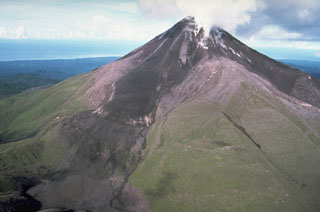Report on Bagana (Papua New Guinea) — August 1995
Bulletin of the Global Volcanism Network, vol. 20, no. 8 (August 1995)
Managing Editor: Richard Wunderman.
Bagana (Papua New Guinea) Vapor emissions produce SO2-rich plume 15-20 km long
Please cite this report as:
Global Volcanism Program, 1995. Report on Bagana (Papua New Guinea) (Wunderman, R., ed.). Bulletin of the Global Volcanism Network, 20:8. Smithsonian Institution. https://doi.org/10.5479/si.GVP.BGVN199508-255020
Bagana
Papua New Guinea
6.137°S, 155.196°E; summit elev. 1855 m
All times are local (unless otherwise noted)
Although one of Melanesia's youngest and most active volcanoes, reports on Bagana are infrequent. Bagana sits along Bougainville's axial highlands ~140 km NW of the 16 August, M 7.8 earthquake's epicenter. Following the earthquake, a report from the Buka Passage Administration Office described a change in activity. Specifically, the report mentioned "black thick clouds coming out of the volcano" and stated that "lava had fallen along the SW coastline." The report included a request for RVO to carry out an inspection. As a result, Chris McKee (RVO) flew around the volcano on 22 August.
McKee noted moderate-to-strong vapor emissions forming a 15-20 km long plume. While the plume looked white near Bagana's summit, downwind a prevailing brown color suggested high SO2 concentrations in the emissions. No ash was noted in the plume. The summit, a region occupied by a blocky lava dome, fed the plume from numerous sources. There was no appreciable force in the emissions and the plume rose only slightly above the summit.
A lava flow that has been active for several years was observed on the volcano's SW flank. In late August the flow's front was estimated to have reached 580 m elevation. In overview, conditions at the volcano appeared stable. There was no indication of recent explosive activity.
Although reports documenting activity have been absent since early 1991, reported Bagana eruptions in the interval 1972-87 described activity that included long-term lava effusion and slow dome growth, coupled with moderate explosive activity ending with dome destruction. After destruction there was a return to dome growth and lava flows.
Geological Summary. Bagana volcano, in a remote portion of central Bougainville Island, is frequently active. This massive symmetrical cone was largely constructed by an accumulation of viscous andesitic lava flows. The entire edifice could have been constructed in about 300 years at its present rate of lava production. Eruptive activity is characterized by non-explosive effusion of viscous lava that maintains a small lava dome in the summit crater, although occasional explosive activity produces pyroclastic flows. Lava flows with tongue-shaped lobes up to 50 m thick and prominent levees descend the flanks on all sides.
Information Contacts: Patrice de Saint-Ours and Ben Talai, RVO.

